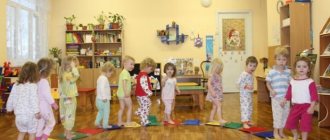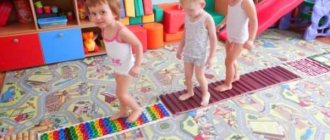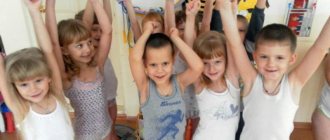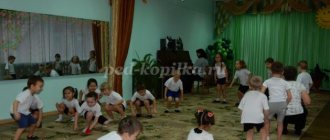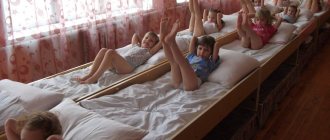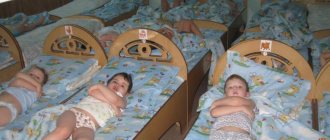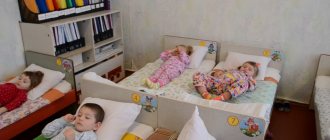Invigorating gymnastics after sleep
Daytime sleep for children, and especially for toddlers, is vital for their proper physical and intellectual development. However, after a nap, babies often remain half asleep or are capricious. How to painlessly transition your baby from daytime sleep to play activities? Awakening gymnastics will help with this, as it helps the child’s body not only wake up, but also improve mood and raise muscle tone. During gymnastics after sleep, you can use musical accompaniment. Music has a positive effect on children's emotions, creates a good mood in them, instills cheerfulness and joy, helps the rhythm of movements, and makes them easier to perform. Kids learn to listen to music and coordinate movements with its character, perform exercises expressively and smoothly. It’s good if, after waking up, children hear their favorite children’s songs or calm, pleasant music, then they will wake up much faster.
Don't forget to smile. The first thing a child should see after sleep is the smiling, kind face of an adult, be it a mother or a kindergarten teacher, and also hear smooth, metered speech, loving intonations, and diminutive suffixes. The very phonetics of these sounds has a positive connotation, regardless of the voice in which an adult pronounces them. Kids subtly feel the emotions of others. Therefore, an adult needs to be attentive to himself, monitor his facial expressions and emotional state. Excitement, anxiety, irritability, and uncertainty of an adult baby are immediately absorbed like a sponge. All experiences will immediately affect the children’s mood.
Invigorating gymnastics should be performed at any time of the year in a well-ventilated area. For young children, seven to ten minutes will be enough.
Options for invigorating gymnastics for kids:
• Warm-up in bed and self-massage;
• Gymnastics of a game nature;
• Gymnastics using a simulator or sports complex;
• Jogging along massage paths;
• Musical and rhythmic gymnastics.
Invigorating playful gymnastics are especially interesting for kids. Such complexes have a plot; they contain a character familiar to children who is a role model. Pre-prepared costumes, character hats, beautiful, bright toys delight children, captivate them, forcing them to move and complete the proposed task.
Children love invigorating gymnastics complexes in the form of musical and rhythmic games. Rhythmic movements are a physiological need of a child’s developing body. Dance movements mobilize physical strength, develop grace, coordination of movements, musicality, strengthen and develop muscles, improve breathing, and actively affect blood circulation. Musical and rhythmic games will not only bring joy to the child, but will also improve the general condition of the body, increase its protective functions, help adapt to unfavorable environmental conditions and fight infections.
Invigorating gymnastics complexes should include exercises to prevent flat feet, poor posture, hand and foot massage, finger and breathing exercises.
Scientists studying the activity of the children's brain and the psyche of children note the great stimulating value of the hand function. The development of fine motor skills of the fingers has a positive effect on the development of children's speech, and the movements of the fingers have a positive effect on the functioning of the speech areas of the cerebral cortex. Finger games help prepare the hand for writing, develop coordination, feel the rhythm and at the same time develop the child’s speech.
In babies, the respiratory muscles are still weak, so breathing exercises are especially useful for them. They promote full physical development and prevent diseases of the respiratory system.
Some complexes of invigorating gymnastics include games and exercises to relieve psycho-emotional stress or games to develop the ability to feel the mood and empathize with others, tongue twisters and pure tongue twisters for memorization, forming clear pronunciation, developing children’s memory.
You can lay out different massage mats on the floor and invite children to perform a task on them: walk on them, stomp on the spot, jump over them, etc. You can make such rugs with your own hands using buttons, wooden sticks, plastic bottle caps, peas, beans, and small stones. Here you can fantasize.
After performing invigorating gymnastics, it is advisable to carry out water hardening procedures (pouring feet, walking barefoot, wiping the whole body with a damp cloth (mitten), washing with cool water). All this contributes to the active inclusion of the child’s body in the working rhythm and gives children the opportunity to improve their health.
Dear parents! Complexes of invigorating gymnastics and hardening can be carried out not only in kindergarten, but also at home.
Sleep plays a big role in a baby's life. One of its main tasks is to restore strength from the past day and give energy for the future. The process of waking up after daytime and nighttime sleep is no less important. Most children wake up in a bad mood, and some little ones cannot be woken up at all. This makes life difficult for young parents, since babies can be in no mood throughout the day. To prevent this from happening, you can regularly introduce a healthy set of home exercises into your awakening ritual. You can do gymnastics with your baby without getting out of bed.
Many kindergartens have been practicing children's gymnastics after sleep for several years. It helps babies wake up easier, gives them energy and helps them spend the day more comfortably. Some exercises can be done at home. It is important to exercise in a positive and playful manner so that it is enjoyable for you and your baby.
Little children grow quickly, so it is important to start light physical activity at an early age. In order to grow healthy they will need a lot of strength and energy. Children who are hardened from an early age rarely get sick, and they are also characterized by healthy activity and curiosity. Such kids love to communicate with peers and easily make contact with people.
Gymnastics after a nap develops well:
- vision;
- speech;
- memory;
- endurance;
- patience.
Invigorating gymnastics after sleep helps to cope with waking up easier. Before starting a set of exercises, it is important to prepare your baby’s bedroom:
- ventilate the room;
- let light into the room;
- remove everything unnecessary from the bed and floor so that it does not restrict movement;
- prepare the music;
- if classes are held with additional paraphernalia, it must be prepared in advance. (ball, jump rope, hoop, massage blanket).
You can start doing the exercises right in bed, after the child has opened his eyes. It is important to gradually increase the pace, not to rush:
- Slow awakening . At first, turn on the music quietly, and as you wake up, you can increase the volume. For a more positive mood, choose music that your baby likes, even if it is not too rhythmic. Let the light into the bedroom, open the curtains. Take the blanket off the baby and run your hands over the baby's entire body, starting from the shoulders and ending with the heels. You can give a light massage to your feet and palms.
- Warm up . The simplest thing to start with is stretching. Let your baby stretch several times. Next, you can show your baby an exercise with lifting arms and legs in turn, and also carefully perform circular movements with the neck. Do breathing exercises with your child: inhale and exhale deeply several times. After the child finally wakes up, you can move on to more serious exercises where you need the baby to stand.
- Easy game exercises . Before starting charging, it is recommended to ventilate the bedroom where the baby sleeps. This is done so that you can combine the process of gymnastics with light hardening. Light exercise includes the following set of exercises: get up and walk on your toes, then on your heels, raise your knees high, roll from heel to toe and back, you can make small circular movements with your hands starting from the shoulders, slow bends from side to side, and also back and forth. Then the load can be gradually increased.
As soon as your baby starts doing gymnastics after sleep, the positive effect will not be long in coming. Waking up will not be as difficult for the baby as it was before. In order for the classes to be effective, it is enough to perform the exercises 3-4 times, alternating the load with rest. Then the baby’s muscles will always be in good shape. It is important to ensure that the child’s breathing is uniform and calm during exercises.
The main purpose of the exercises after waking up is that the child, by performing them, moves more easily from a sleepy state to wakefulness.
Exercising after sleep has the following positive effects:
- improves mood;
- increases the child’s perseverance;
- prevents various diseases (scoliosis and flat feet);
- strengthens the respiratory tract system;
- improves the nervous system (makes it more resilient);
- makes the child's immunity strong;
- From childhood, a child begins to lead a healthy lifestyle, starting his day with exercise.
Gymnastics after night and daytime sleep does not make any fundamental difference. The only thing that needs to be adjusted is the time. After waking up at night, you should not study for more than 15 minutes. But after a nap, you can do gymnastics for about half an hour. It is necessary to monitor the child’s condition; the set of exercises should not be tiring. It is important that he finds it interesting and fun. Otherwise, the baby may get bored and subsequently lose interest. To prevent this from happening, monitor your baby’s condition and adjust the time based on his mood. After just a few days of practice, you will know exactly what your child likes.
There are different sets of exercises for each age group. What is suitable for a 2-year-old child will no longer be entirely relevant for a child who is 3 years old or more. Therefore, when choosing exercises, it is important to look at the child’s physical fitness and take into account age restrictions.
Children of school and preschool age can perform more complex physical exercises:
- Cat . The child gets on all fours and bends his back down and back up. The back takes the shape of a wheel.
- Kolobok . The baby lies on his back, tucks his knees to his stomach, wraps his arms around his legs and rolls back and forth, working his abdominal muscles.
- Bike . One of the most popular exercises. It is often done not only by children, but also by adults. The exercise is performed while lying on your back. The child raises his legs and begins to make circular movements, imitating riding a bicycle.
If you do gymnastics, follow all the rules, but the child still wakes up cranky, out of mood, or doesn’t want to get up at all. It is worth paying attention to the rhythm of the baby's day. How long does he stay awake, does the baby sleep enough for his age, is there time in his daily routine for relaxation before bed? Certified children's sleep consultant Tatyana Kremneva will help you understand these and many other questions regarding children's sleep. Come to the “Baby’s Dream” Instagram page, read posts, watch live broadcasts.
Children who exercise after sleep are less likely to get sick or tolerate various diseases much easier. Before you start practicing home gymnastics, you can consult your pediatrician about contraindications.
Author: Tatyana Kremneva.
